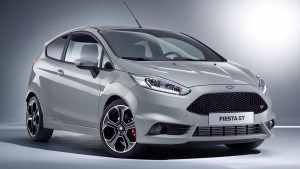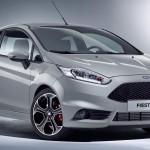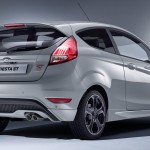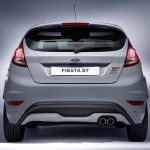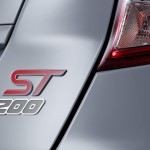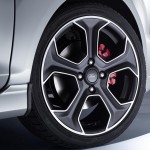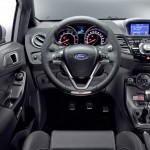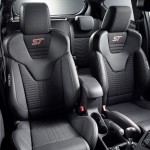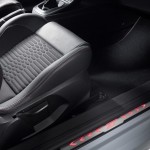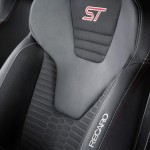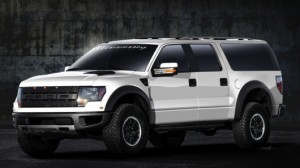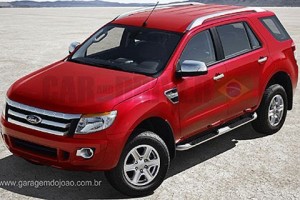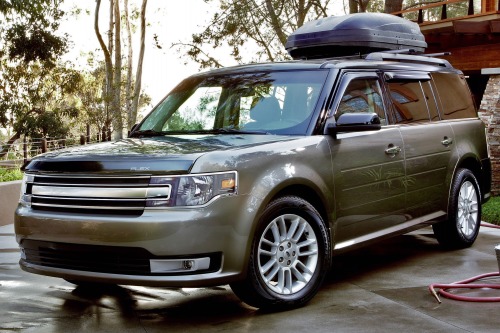Tag Archives: ford
Ford Fiesta ST Upgraded To 200 BHP
The Ford Fiesta ST hatch has gotten a good upgrade with 200 bhp and a nicer trim. We expect to see this at the Geneva Auto Show this March 1.
This would definitely steal some spotlight from the other hatchbacks and sedans currently lined up for the motor show. The hatch’s iteration was given more power plus a nicer trim since its going to presumably end its run soon.
Some who bought the Ford Fiesta ST may be slighted with the release of the ST200 model, but those who can get their hands on the new iteration would be greatly pleased.
According to TopGear, the changes aren’t exactly earth shattering, but they are enough to merit a second look. The Ford Fiesta ST200 will have a 1.6-litre turbo petrol engine that ups the ante to 197bhp (or 200PS, hence the name), shaving a couple of tenths off the 0-62mph time, which now stands at 6.7 seconds.
Ford is also promising better in-gear performance, so its six gears should just be enough.
Ford also allows special specification and customization of the ST200. There’s a new “Storm Grey” paint, some fancy matt black alloys, and lots of nice red detailing inside and out.
All of these features are exclusive to the ST200, which only 500 will be made each year. This will, of course, keep their bragging rights strong. This might strongly remind you of the And if you recognise the short-run 2.5-litre V6 Mondeo ST200, released in 1999.
Prices have yet to be announced, but we are expecting the ST200 to be somewhere near the £21,000 range. Expectedly, some may frown at this since it’s a few thousands more than the standard edition, but the ST200 is a bargain compared to the Renaultsport Clio Trophy or Peugeot Sport 208 GTI, both will probably cost around £22,000 once they are released.
Hennessey Roars in with its 2013 Ford Velociraptor SUV
Well renowned for refurbishing various monster machines over the past two decades, Texas-based designer and tuner John Hennessey converted Ford’s F-150 Raptor SVT crew cab pick-up into a full-fledged Sports Utility Vehicle (SUV) with seating available for eight passengers watching the seamless popularity of the Ford pickup especially from SEMA show in 2012. Hennessey Performance garage had already been offering an overhauled version of F-150 Raptor with an upgraded engine pacifying the needs of buyers who wanted more from the van than 411 horsepower. HPE have, since past three years, produced over 400 Raptor beasts and are overwhelmed to offer Velociraptor trucks for sports enthusiasts.
As the F-150 SVT crew cab from Ford factory travels through a series of dealers and is reached at the Hennessey Performance garage, the trailer from the crew cab and the top of pickup bed is scythed off and new parts are welded for attachment of rear set of doors. Original shaded glass windows from the discontinued in 2005 Ford truck, Excursion are installed above the rear set of wheels after masking with new sheet-metal and painting. Following this is the process of addition of a melded three door tailgate, acquired from the Excursion as well, is mounted surgically in place of the raptor trailer tailgate without altering the taillights and rear bumper from the Raptor.
The recently added trailer bed is carpeted and padded, while the padded interior contour lines which cover the sidelines are adapted from the Excursion, too. Then the roof which is insulated with a thick insulation layer is covered with a dark character. Hennessey remarked this was to make the interiors appear, as company-like as possible. The wings of the van remain aboard while modern cues have been grafted onto the body. Chasmal interiors are exposed as the rear compartment is opened, largest in the sports utility market. It is a customer’s decision so as to what to do with the interiors – they could leave it hollow or place a second and even a third row for added seating up to eight riders. Additional mechanical upgrades like fancily wrapped aggressive tires, better Brembo brakes and armour option, alongside interior LED lighting, custom upholstery and entertainment add-ons are available.
Hennessey offers a stock 411 horsepower unit with a 6.2litre V-8 engine that fires from 0 to 97kmph in a span of 7.5 seconds while an alternative supercharged version, a 600 horsepower unit due to which Velociraptor 600 derives its identity, which despite of added 200 kg of weight reaches 97kmph mark in just 5.9 seconds. Moreover, Hennessey is developing another 800 horsepower behemoth for much more curious souls. Even after this beasty performance, on pushing the pedal right, the interior cabin remains silent, while for customers seeking roaring engine can opt for exhaust solutions. Apart from so many changes, the Velociraptor is essentially a Raptor ahead of the front door including stock dashboard and meters, and unchanged wheelbase and chassis.
The success of the beast is certainly enthralling even after rising concern for the fuel prices, but the edition vehicle is restricted to a limited audience because of its base pricing of $159,500 and thus Hennessey is determined to narrow production to only 30 units per year.
Ford Everest 2014 Concept Debut for Australia
Ford fanatics have been affected with the tentative news of Ford’s plans of ceasing production of the Territory and Falcon in Australia by 2016. A closure estimates that folks employed for production are meant to walk out, and look up for new jobs. But this termination has not been linked with termination of Ford’s tenure in Australia and is not designated to show that plans of crumbling to numbness any time soon, by unveiling Ranger-based Everest concept which is set to light up the markets by 2015.
Ford has been bracing its line-up for expansion in the market in 2017 by adding an assailant to the brigade when it launches eleven new products. Ford has flaunted its commitment to Australia by releasing a rough and tough seven-seater, not actually set to replace the senior Territory, a job either Flex or Edge shall accomplish. The Everest will be a true off-roader, and shares it blueprints from the Ranger pickup truck. Whilst the two previous production models of the Everest, dubbed Endeavour in India, were produced in Thailand since 2003, the newer member of the family is likely to be sold in Australia itself, too. It is conjectural that post production, the Everest will reach out to other undiscovered markets as indicated by Mark Fields, Ford’s COO. However, it is unlikely that the Everest sells in the home market, since similar sized SUV’s already reign the region.
Ford has recently released pictures of the hero in the market, which flaunts its design lifted slightly from the Ranger, and a Ford’s mundane trapezoid three-stroke grille which dragoons the front face of the Everest. Everest receives a revamped bonnet, placed above front quarter panels, and Ranger relayed A-pillars, with subtle tailoring. The rear end is entirely refreshed, adorning the Everest headline, big enough and chrome-lifted along with wider new tail lights. Thin and aggressive headlamps are set to lift the Everest to an equal peak.
Although no official notifications have been flagged yet, many patrons have speculated that the Everest might acquire one of the two engines featured already on the Ford Ranger UTE which is either 2.2-litre or 3.2-litre five cylinder turbocharged diesel engine, but considering the fancy for reduced carbon footprints the Everest might also route itself onto the EcoBoost way. The Ranger’s ladder frame chassis entice as a part of Ford’s new strategy at design for 2017 shoot-out.
Despite of the acts that might exhibit Ford’s steps to uproot itself from Australian premises, Bob Graziano, Ford Australia President and CEO, ensured that employees and customers that they are dedicated to them through a sequence of launches lined up in the recent present and cutting-edge leading technologies. Apart from being misunderstood as the Dodge Durando from a far off vision due to similar grille and headlight location, the Everest is set to share market with Toyota Forerunner, Mahindra SsangYong Reston, Mitsubishi Pajero Sport besides being shared in Ford’s refreshed line up for the 2017 scenario, where it shall share space with a refreshed Falcon from the Ford shed, as well.
Boxy, Yet Amazing…the New 2014 Ford Flex
With the square and flat, solid face that it carries, Ford Flex 2014 can certainly not just be titled as a family car housing 7 passengers, reminding of the old school station wagons dating back to 1960s and 70s showing off a silken look sleeker than other SUVs. The Flex is a one of its kind innovation. Compared to its competitions in the market namely Chevrolet Tahoe, Honda Pilot etc. focuses over ride quality than off-roading capabilities.
With a seating configuration of 2-3-2 the Flex is aimed pin-pointed at people, until the rear seats are folded and its directions alter to cargo, but not being built upon solid body-on-frame chassis, the Flex is dissimilar to a van. Initially called a Crossover Utility Vehicle by Ford, it has now been decided to be called just a Utility Vehicle rather, the entitlement being unclear. The Flex could be really called a modern version of the old American station wagon clan. It would best be called a crossbreed between a limo and a taxi, not well suited for heavy off-road business. The 2014 Flex received minor tweaks in this year’s model, after last year’s extensive redesign and mechanical upgrade.
The Flex is packed in a box full of stylish confetti with great riding comfort and long journey pleasures. The shape seems to be just apt for an elegant box, simple and sweet, with sharp edges and a rounded front. It utilizes maximum space and provides large interior space while presenting a bold image. The three screen instrumental panel is easy to use and simple while it is a home to the new MyFord Touch System. The rear compartment refrigerator and voice-controlled Sync Communication system have undoubtedly been the favorites of the show. Forgetting its wide body and long wheelbase, the Flex is good enough to respond to your driving requirements. The ride overall is fairly smooth and it quests very well over tight turns, while the quiet interiors add on to the amenity if offers. The Flex boasts a low ground posture, managed nicely because of the large wheels and taut suspension. The electric power steering often arrests the feel, but works well. Despite of its squared appearance, Flex manages to flow through the air at great speeds. An option of contracting color of the roof and a lift gate adorned in brushed aluminum enhance the looks greatly.
The base 3.5L V-6 engine with a power of 287 horsepower, with a fuel economy of 18 mpg in city and 25 mpg on the highway, provides just enough acceleration while a twin-turbo V-6 EcoBoost engine with a power of 365 horsepower adds a thrill to the ride, though compromising on the fuel economy by 2 mpg . An all-wheel-drive system ensures tight grips on snowy and slippery tracks. A 6-speed automatic transmission is available with both engine variants while options of Front-wheel-drive and All-wheel-drive are available for buyers.
The Ford Flex is a clear winner for somebody looking for roomy interiors and soothing long rides but it certainly cannot double as an SUV or a crossover. Although the package is bundled with latest technology and has offers comfortable, smooth and fast rides it fails to please buyers expecting more from its looks.
2014 Ford Edge Proves To Be A Versatile Choice!
People often get stuck in the decision of which SUV to buy, a large SUV for maxing cargo storage and third row capacity while some ponder upon greater fuel economy and swift movability in the city, choosing small utility vehicles, instead. Many, meanwhile, are attracted towards the middle ground choosing for a Mid-range crossover vehicle where Ford Edge echoes with the needs of most buyers.
The love for Ford Edge originates from its high-tech features and attractive interiors which include blind-spot warning, adaptive cruise control, dual-screen rear entertainment system and cross-traffic alert, Sync voice-controlled system and a three-display MyFord Touch interface coupled with an easily maneuvering figure. Edge’s 265 horsepower, 3.6 L V-6 engines impresses well with the acceleration via a six-speed automatic transmission along with a road-oriented AWD configuration for slippery roads and snowy terrains, though it has been fabricated for off-roading purposes. Paying extra for a four cylinder turbocharged engine brings along a superb fuel economy of 30mpg on highway along with extra added enormous power. The electronic interface boasted well by Ford has invited itself criticism for being complex to use and miffing for users, while the restriction to seating capacity of five and no off-roading abilities may disappoint a vast buyer population.
The 2014 Edge is available in SE, SEL, Limited and Sport variants. The base SE packages a V-6 engine with 17 inch alloy wheels and basic functionality feature along with an add-on convenience pack that presents benefits like exterior keypad entry, rear parking sensors, automatic rearview mirror dimming and automatic headlights along with additional satellite radio and Sync Voice Command Interface. The SEL has home for all SE features along with 18-inch alloys and 8-way power driver seat with the steering wheel wrapped with leather. Leather Comfort package adds on leather upholstery, 6-way foldable passenger seats and front seat warmers. Other options include a MyFord Touch Interface with benefits of turn-by-turn 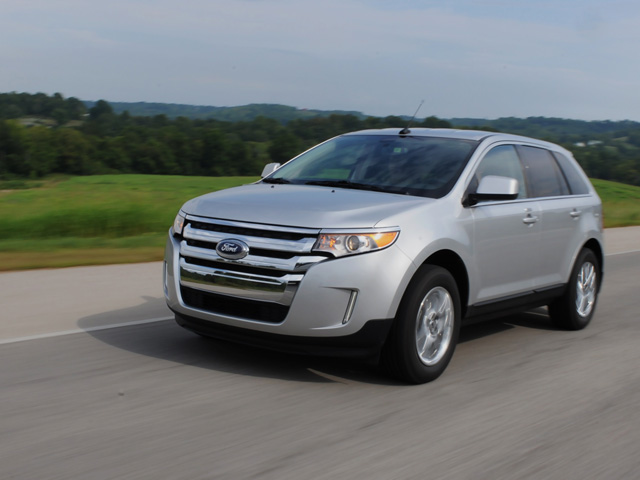 navigation. The Driver Entry Package in Limited features keyless entry and ignition, remote ignition and power liftgate apart from the basic SEL model and addition 12-speaker sound system from Sony with HD Radio and heated mirrors. The Edge Sport, alternatively bundles a 22-inch alloy wheel system with a retuned suspension, integrated special interiors and a beastier V-6 engine.
navigation. The Driver Entry Package in Limited features keyless entry and ignition, remote ignition and power liftgate apart from the basic SEL model and addition 12-speaker sound system from Sony with HD Radio and heated mirrors. The Edge Sport, alternatively bundles a 22-inch alloy wheel system with a retuned suspension, integrated special interiors and a beastier V-6 engine.
For safety Antilock disc braking system, front-seat side airbags and full length curtain airbags along with stability control come standard in all models. Add-ons in the Vision package include blind-vision and cross-traffic warning system. Another option for all trim variants except sport is a 2.0 L four-cylinder turbocharged EcoBoost engine that has a 270 lb-ft of torque and produces 240 horsepower. It goes from 0 to 60mph in 8.4 seconds and furnishes a mileage of 24mpg in city with 30mpg on the highway.
The 2014 Edge is well known for its driving comfort and quiet, soothing and bump-free ride with a solid, concrete built. Its handling is secure with all the effective safety features and cutting corners and parking is hassle-free. The sports model, meanwhile, is more swift and sharper but its husky wheelbase degrades ride quality beyond acceptance for some. Despite of the enormous V-6 engine it leaves many people craving for more power.
2013 GMC Acadia vs. 2013 Ford Explorer
GMC Acadia VS Ford Explorer
It is not necessarily easy to compete in the large crossover SUV category, but GMC Acadia and Ford Explorer manage to deliver standout performances in two very different ways. Both vehicles give you strong engines, impressive towing capabilities, third row seating and a ton of technology features, but while Ford takes the sporty and modern approach, GMC appeals to the more classic and elegant-minded buyer. Regardless which vehicle you choose, you are sure to enjoy a rewarding experience cruising in-city, on the highway, or down a secluded country road.
Performance
Every Acadia is powered by a 3.6-liter engine that buyers have come to trust and truly rely on through the years. It delivers 288 horsepower and 270 pound-feet of torque, and can tow 5,200 pounds with ease. All-wheel drive is available to provide you with an extremely intelligent powertrain capable of reacting to changing driving conditions. Fuel economy is average for this segment, returning 17 mpg in the city and 24 mpg on the highway.
Ford gives you a few different options. Explorer’s standard engine is a 3.5-liter V6 mated to a six-speed automatic to deliver 290 horsepower and 255 pound-feet of torque. Hill start assist and hill descent control are included. it can reach 60 mph in 8.3 seconds, and yields 18 mpg in the city and 25 mpg on the highway. Properly equipped, towing capacity is 5,100 pounds.
Those opting for Explorer Sport will enjoy a turbocharged version of this same engine to boost performance to 365 horsepower and 360 pound-feet of torque. There is also a turbocharged “EcoBoost” 2.0-liter four-cylinder available on front-wheel drive models that delivers 240 horsepower and 270 pound-feet of torque. Acceleration speeds drop but fuel-economy is impressive at 20 mpg in the city and 28 mpg on the highway.
Driving and Handling
Although large, both SUVs are known for handling quite nicely. Will you need to slow down a little around turns? Probably! However, you won’t feel as though you are driving a tank either, like you might expect.
Acadia gets a fully independent suspension so bumps felt by one wheel are not transferred to the others. This helps to deliver a smooth and comfortable ride. Ford feels solid, even at highway speeds and the electric power steering system is incredibly responsive. Both vehicles will give you a commanding view and feel of the road, so whether you are stuck in traffic in, or cruising the back country roads you will feel confident.
Safety
Top safety scores in roof, front and side-impact protection from the Insurance Institute for Highway Safety can be appreciated in Acadia and Explorer. These are family-friendly vehicles that have been designed with safety in mind. Acadia boasts a Front Center Air Bag, which is an industry first while Explorer gets Ford’s Curve Control; a feature that can monitor speed entering a corner and slow the vehicle down if needed.
Ford gives you the MyKey® system, allowing parents the power to set audio and speed control for younger drivers while GMC gives you OnStar, providing roadside assistance, automatic crash response and more.
Exterior
As mentioned, these SUVs provide two very distinct looks. Acadia is classic and sophisticated while Explorer is modern and sporty. Acadia gets full redesigned for 2013, with a new hood, front fascia, grille and wheel options. It offers a confident stance with clean lines and gorgeous new projector beam headlamps.
Explorer received a redesign two years ago, and fortunately, Ford did not fuss with it because it is the best design yet. Black lower bumpers offer a rugged look while chrome accents and a satin silver grille provide a modern attitude. Explorer has an agile, fluid look that Ford fans love, and the available 20-inch wheels are a must-have.
Interior
Both provide three rows of seating, but if you plan on using your third row for adults, Acadia would be your best option. Explorer’s third row is better suited for children, however Explorer also gives you a power-folding rear seat. Acadia seats up to eight passengers with more than enough room for adults to fill all three rows. The second row does slide easily to provide access the third row.
GMC gives Acadia a revised center console and handsome cabin accents while Ford has one of the most user-friendly interfaces on the market.
Technology and Entertainment
The Color Touch Radio with IntelliLink® is a highlight in Acadia, but is it enough to compete with SYNC®? These interfaces are very similar yet quite unique, so getting familiar with both could sway you toward one vehicle or the other.
Both vehicles also offer a rear seat DVD entertainment system to keep passengers entertained on the road. Acadia’s Color Touch Navigation System is vivid, easy-to-use and integrates seamlessly with SiriusXM® Traffic and Weather, but the 12-speaker Sony® audio system available is hard to pass up.
Image thanks to money.cnn.com
2013 Ford Edge vs. 2013 Hyundai Sante Fe
2013 Ford Edge VS 2013 Hyundai Santa Fe
Choosing between the Ford Edge and Hyundai Santa Fe is not a decision that will likely come easily. In the midsize crossover segment, these are two that really stand out, so there is a good chance that there are a lot of elements in both vehicles that you are really drawn to. They both offer a modern exterior, comfortable cabin and strong engines, but you will have to decide which one you can see yourself in cruising around in.
Performance
Both Escape and Santa Fe have three engines available and they are quite competitive. The base engine in Santa Fe is a 2.4-liter that offers 190 horsepower and a decent 181 pound-feet of torque, and returns 21 mpg in the city and a very generous 29 mpg on the highway. This is pretty impressive fuel economy for a crossover! Edge does not have a four-cylinder in its base model; it opts for a 3.5-liter V6 that delivers 285 horsepower and 253 pound-feet of torque. Fuel economy is still better than average at 19 mpg in the city and 27 mpg on the highway.
All Edge models except Sport can be equipped with a turbocharged 2.0-liter four-cylinder that produces 240 horsepower and 270 pound-feet of torque. Zero to 60 mph is achieved in 8.4 seconds and fuel economy is 24 mpg combined. Lastly, Ford Sport is motivated by a 3.7-liter V6 good for 305 horsepower and 280 pound-feet of torque. It reaches 60 mph in 7.5 seconds and yields 22 mpg combined.
The optional engines in Hyundai are equally impressive. Santa Fe Sport gets a turbocharged 2.0-liter four-cylinder that delivers 264 horsepower and 269 pound-feet of torque and yields 23 mpg combined. Large GLS and Limited models receive a 3.3-liter V6 that boasts 290 horsepower and 252 pound-feet of torque. All-wheel drive is available across the lineup on both vehicles.
Driving and Handling
One of the reasons Edge and Santa Fe are so popular is because they are fun and easy to drive. A small turning circle on both means that they can easily be maneuvered in tight spaces, making them attractive the person who parks in a lot of parking garages or busy lots.
Edge is well-known for its well-composed, comfortable and vault-like ride. Steering is responsive, and it manages to corner nicely without much noticeable body roll.
Santa Fe gives you a compliant ride. It does not matter if you drive the regular or Sport, you feel confident whether you are merging onto the highway or cruising around town.
Safety
Safety is just one more area where Edge and Santa Fe dominate this segment. Both received top safety scores in roof, front and side-impact protection when crash-tested by the Insurance Institute for Highway Safety. Ford does have a slight “Edge” in braking capabilities though. Edge stops from 60 mph in 122 feet, which is significantly better than average. Hyundai is close behind at 127 feet.
Standard on Edge is the Ford MyKey® system that lets parents set audio and speed controls for teenage drivers. It also offers innovative optional safety features on certain models, such as collision warning, cross-traffic and blind-spot warning systems.
On Hyundai Santa Fe you get Blue Link®, an emergency telematics system, providing emergency assistance, theft-recovery, remote access and more.
Exterior
Hands down, these are two of the best-looking crossovers on the road. Hyundai’s styling was designed in Southern California, inspired by the picturesque landscape no doubt. It is aerodynamic, and boats plenty of thoughtful details like a shark-fin antenna, rear spoiler and chrome accents. The 19-inch alloy wheels are a must-have option!
Edge also commands attention on the road. The bold, fluid front grille is complemented nicely by the projection beam halogen headlamps. In the rear, 4-inch bright chrome exhaust tips and sculpted tail lamps are the perfect finishing touches.
Interior
The interior is where you see the greatest difference between these two vehicles. Edge seats five passengers comfortably while Santa Fe has third row seating available for a seven-passenger configuration. There is plenty of leg and headroom for passengers in both vehicles, and seats are comfortable yet supportive.
Edge is modern, but the three display screens may take you a bit to get used to. Hyundai went all out for this year’s redesign and give it one of the nicest cabins in the segment with plenty of high-quality materials.
Technology and Entertainment
You can go ahead and prepare to be impressed by the technology features in these two crossovers. They are neck-and-neck with everything else; might as well compete nicely in the technology department as well.
You will find navigation systems available in both, and while Ford gives you SYNC® voice-activated technology, Hyundai gives you Blue Link®. As far as upgraded audio systems goes, they are both tied again. Edge has an optional 12-speaker Sony® system available while Santa Fe boasts a similar set up by Infinity Logic®.
Image thanks to www.wbng.com
Ford Escape vs. Mazda CX-5 – Full Comparison
Ford Escape VS Mazda CX-5
If you find yourself being forced to flip a coin between the Ford Escape and Mazda CX-5, you are not alone. These are two hot vehicles with their own list of fantastic qualities. On one hand, you have Escape, which pretty much dominates the small crossover segment. Then, you have CX-5, an all-new vehicle that has a lot to love. So, do you choose the vehicle with proven reliability, or do you opt for a vehicle that you won’t see very many of yet on the roads of wherever you happen to live?
Performance
There are three engine choices available in Ford Focus, but two for Mazda CX-5. Mazda gives its small crossover a hearty 2.0-liter four-cylinder that is good for 155 horsepower and 150 pound-feet of torque. A six-speed manual is standard, but a six-speed automatic is available, and must be selected to have all-wheel drive. This is a fairly light vehicle, so despite the small engine, acceleration speeds are decent, taking 9.3 seconds to reach 60 mph. Mazda says it’s CX-5 will yield 26 mpg in the city and 33 mpg on the highway. For more power, there is a 2.5-liter SKYACTIVE®-G available that generates 184 horsepower.
The base engine on Escape is a little more powerful than CX-5. A 2.5-liter four-cylinder offers 168 horsepower and 167 pound-feet of torque, and returns 22 mpg in the city and 31 mpg on the highway. A turbocharged 1.6-liter inline-4 is standard on SE and SEL. It delivers 178 horsepower and 184 pound-feet of torque, and can generously tow 3,500 pounds, when properly equipped. Lastly, a turbocharged 2.0-liter inline-4 is standard on Titanium and optional on SE and SEL. It produces 240 horsepower and 270 pound-feet of torque yet manages to yield 25 mpg combined. All-wheel drive is available on all models, except the “S” trim.
Driving and Handling
When it comes to handling, Escape has earned its reputation as a spirited and easy-to-drive vehicle. Many slip behind the wheel expecting it to be awkward and clumsy, due to size, but it is surprisingly agile. Everything from the braking to the steering to the suspension is more than capable, and you don’t feel much body roll on winding roads.
CX-5 does not have the reputation Escape has, but it only takes one test drive to find that the new vehicle handles itself quite nicely on the road. It is not the fastest or quietest choice, but the ride is smooth, comfortable and capable.
Safety
There is something to be said about buying a vehicle with a trusted reputation, especially if safety is on your mind. However, CX-5 has already been put through roof, front and side-impact crash tests, and received top safety scores from the Insurance Institute for Highway Safety.
CX-5 has high tensile steel reinforcements and side-impact door beams to help keep passengers safe. If there is an accident, the fuel cuts off, and blind-spot monitoring is also available. Escape gives you a long list of safety features that faithful Ford buyers have grown to appreciate and even expect, such as post-collision safety system, tire-pressure monitoring, turn signal mirrors and engine immobilizer.
Exterior
You can’t go wrong with the exterior of either of these vehicles. Although CX-5 is a brand new vehicle, Escape is fully redesigned for the model year, so either way, you will be cruising around in something fresh and exciting.
Escape boasts a little international lineage that you can see in the harmonic balance created by an athletic stance and graceful lines. From its sculpted wheel arches to its trapezoidal-shaped lower grille to the bright dual exhaust tips, this is a vehicle that will turn heads from every angle.
CX-5 boasts Mazda’s “Soul of Motion” design philosophy with fluent and flowing lines that make the vehicle appear as though it is always in motion. It also offers some fantastic wheel choices in 17, 18 and 19-inch sizes.
Interior
The cabin in both of the vehicles will impress you. They are both thoughtfully designed and modern, and offer a surprising amount of room. Ford’s redesign for Escape leaves it with an upscale feel. Gauges are easy-to-read and controls are in reach. The materials used offer an improved quality; this is just a nice cabin to be in. Plus, the front seats are generously padded and given plenty of bolstering for support.
A highlight for CX-5 would have to be the black gauges that have white lettering. They are incredibly easy to read and almost soothing on the eyes. There are plenty of soft-touch surfaces, and an abundance of legroom can be appreciated in both rows.
These vehicles are neck-and-neck in terms of cargo space. Behind the front seats, Mazda CX-5 offers 65 cubic feet while Escape is at 68.1 cubes.
Technology and Entertainment
There is absolutely no shortage of technology in either of these vehicles. In fact, you may forget you are in such a modestly priced vehicle when you see all the bells and whistles. A huge highlight for Escape is the foot-activated tailgate. SYNC® lets you use voice commands to control just about everything from Bluetooth to audio. Speaking of audio, the available Sony® system is well worth upgrading to as it gives you 10 premium speakers, a dual-channel subwoofer, HD Radio, iTunes® Tagging and 355 watts of power.
CX-5 has a nine-speaker Bose® system available that offers Pandora®, HD Radio, and SiriusXM Satellite Radio. Plus, it has a fantastic optional navigation system by TomTom® that includes a 5.8-inch display with voice recognition.
Image thanks to www.goauto.com.au

